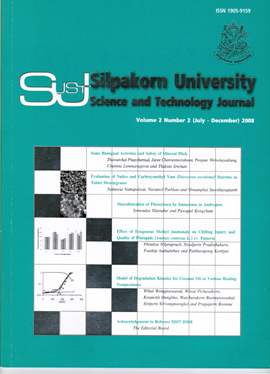Effect of Exogenous Methyl Jasmonate on Chilling Injury and Quality of Pineapple (Ananas comosus L.) cv. Pattavia
Main Article Content
Abstract
This experiment was carried out to determine the effect of methyl jasmonate (MeJA) on chilling injuries andquality of pulp in pineapple (Ananas comosus L. cv. Pattavia). The effect of exogenous MeJA on quality andstorage life of pineapple cv. Pattaviawas was investigated. Pineapples were treated with 0 (control), 10-3, 10-4and 10-5M MeJA and then stored at 10 °C, 85% relative humidity. Pineapple treated with MeJA significantlyreduced chilling injuries and percentage of fruit weight loss compared to the control treatment. Percentage ofweight loss of pineapple non-treated with MeJA was ranged from 13.73-19.64%, while that of treated pineappleranged from 3.81-11.99%. After storage for 21 days, the browning symptoms associated with chilling injurieswere observed in the pulp adjacent to the core of the pineapple fruit. Chilling injuries were found to be associatedwith electrolyte leakage, chilling injury index and total phenolic content, which had increased during storage. Thevalue of electrolyte leakage, chilling injury index and total phenolic content from pulp tissue treated with MeJAwas lower than with non-treated fruits. Total soluble solids (TSS), titratable acidity (TA), total sugars andreducing sugars of treated pineapple were not significantly different from that of the control pineapple.
Downloads
Article Details
References
Chen, C. C., Lili, Z., Nancy, C., and Paull, R. E. (2001). Determinants of sweetness in papaya and pineapple. Proceedings of the fourth international conference on postharvest science. Acta Horticulturae, 553: 99-100.
Creelman, R. A. and Mullct, J. E. (1997). Biosynthesis and action of jasmonates in plants. Annual Review of Plant Physiology and Plant Molecular Biology, 48: 355-381.
Droby, S., Porat, R., Cohen, L., Weiss, B., Shapiro, B., Philosoph-Hadas, S., and Meir, S. (1999). Suppressing green mold decay in grapefruit with postharvest jasmonate application. Journal of the American Society for Horticultural Science, 124: 184–188.
Dull, G. G. (1971). The pineapple. In The Biochemistry of Fruits and Their Products (Hulme, A. C., ed), pp. 303-324. Academic Press, New York.
Given, N. K. (1993). Kiwifruit. In Biochemistry of Fruit Ripening (Seymour, G., Taylor, J., Tucker, G., eds), pp. 235-254. Chapman & Hall, London.
Gonzalez-Aguilar, G. A., Buta, J. G., and Wang, C. Y. (2001). Methyl jasmonate reduces chilling injury symptoms and enhances colour development of ‘Kent’ mangoes. Journal of the Science of Food and Agriculture, 81: 1244–1249.
Gonzalez-Aguilar, G. A., Buta, J. G., and Wang, C. Y. (2003). Methyl jasmonate and modified atmosphere packaging (MAP) reduce decay and maintain postharvest quality of papaya Sunrise. Postharvest Biology and Technology, 28: 361–370.
Gonzalez-Aguilar, G. A., Fortiz, J., Cruz, R., Baez, R., and Wang, C. Y. (2000). Methyl jasmonate reduces chilling injury and maintains postharvest quality of mango fruit. Journal of Agriculturaland Food Chemistry, 48: 515–519.
Hodge, J. E. and Hofreiter, B. T. (1962). Method in carbohydrate chemistry. In Determination of Reducing Sugar and Carbohydrate (Whisstter R. L. and Wolfrom M. L. eds), pp. 380-394. Academic Press, New York.
Ketsa, S. and Atantee, S. (1998). Phenolics, lignin, peroxidase activity and increased firmness of damaged pericarp of mangosteen fruit after impact. Postharvest Biology and Technology, 14: 117-124.
Lyons, J. M. (1973). Chilling injury in plant. Annual Review of Plant Physiology, 22: 445-456.
Marrero, A. and Kader, A. A. (2006). Optimal temperature and modified atmosphere for keeping quality of fresh-cut pineapples. Postharvest Biology and Technology, 39: 163-168.
McCollum, T. G. and McDonald, R. E. (1991). Electrolyte leakage respiration and ethylene production as indices of chilling injury in tomatofruit. Hort Science, 17(2): 162-165.
Meir, S., Droby, S., Davidson, H., Alsevia, S., Cohen, L., Horev, B., and Philosoph-Hadas, S. (1998). Suppression of Botrytis rot in cut rose flowers by postharvest application of methyl jasmonate. Postharvest Biology and Technology, 13: 235–243.
Mitra, S. K. (1997). Postharvest Physiology and Storage of Tropical and Subtropical Fruits. CABI Publishing, New York.
Moline, H. E., Buta, J., and Safther, R. A. (1997). Comparison of three volatile natural products for the reduction of postharvest decay in strawberries. Advances in Strawberry Research, 6: 43–48.
Mueller, M. J., Brodshelm, W., Spannagl, E., and Zcnk, M. H. (1993). Signaling in the elicitation process is mediated through the octadecanoid pathway leading to jasmonic acid. Proceedings of the National Academy of Sciences, 90: 7490-7494.
Nukuntornprakit, O. (2004). Free radical and antioxidants on internal browning inpineapples. Master of Science (Thesis). Department of Horticulture. Kasetsart University, Bangkok.
Paull, R. E. (1994). Chilling injury of crops of tropical and subtropical origin. In Chilling Injury of Horticultural Crops (Wang, G. Y., ed), pp. 17-36. CRC Press, Florida.
Paull, R. E. and Rohrbach, K. G. (1985). Symptom development of chilling injury in pineapple fruit (Ananas comosus). Journal of the American Society for Horticultural Science, 110: 100–105.
Plews, R. W. (1970). Analytical Methods Used in Sugar Refining, Elsevier Publishing, New York.
Vamos-Vigyazo, L. (1981). Polyphenoloxidase and peroxidase in fruits and vegetables. Critical Reviews in Food Science and Nutrition, 15: 49-127.
Walker, J. R. L. and Ferrar, P. H. (1998). Diphenol oxidase, enzyme-catalysed browning and plant disease resistance. Biotechnology and Genetic Engeering Reviews, 15: 457-498.
Wang, C. Y. (1998). Methyl jasmonate inhibits postharvest sprouting and improves storage quality of radishes. Postharvest Biology and Technology, 14: 179–183.
Wang, C. Y. (1990). Chilling injury of horticultural crops. In Relation of Chilling Stress to Membrane Permeability (Murata T. ed), pp. 201-210. CRC Press, Florida.
Wang, C. Y. and Buta, G. (1994). Methyl jasmonate reduces chilling injury in Curcubita pepo through its regulation of abscisic and polyamine levels. Environmental and Experimental Botany, 43: 427–432.
Weber, H. (2002). Fatty acid-derived signals in plants. Trends in Plant Science, 7(8): 217-224.

